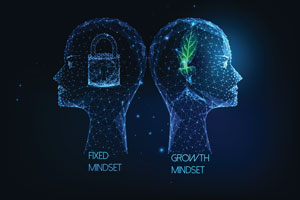If you speak to most people, they will tell you that they feel as if are on a permanent rollercoaster they can’t get off. The pace of modern business and the related stress that comes from facing constant change and disruption is turning many into the worst version of themselves - commanding, overwhelmed and distracted. And it’s not letting up anytime soon. And it’s not just a public-sector thing.

The challenges leaders face across industries, geography and cultures are shockingly similar. So, if you feel like you are experiencing life like you’re driving in the movie fast and furious, you’re not alone. It doesn’t matter what line of work you are in or how high up the food chain you sit. Adversity is the new normal and it’s getting harder to keep up with the rapid pace of human advancement and the impact it’s having on our lives.
The secret is cultivating a growth mindset which enables you to do exactly that - the ability to move fluidly between the two worlds of the present and future, strengthened not crippled by extreme challenges you must solve for, or risk get left behind. It’s how Satya Nadella successfully turned around the plummeting Microsoft several years back, by getting his leaders to focus on actively developing theirs.
But what is a growth mindset, and how do you know you’ve got one?
Growth mindset is a state of mind fuelled by the principle that every human being has more energy, talent and potential to deliver. It’s a belief that intelligence is not something you have or don’t have, but something you can continue to develop. On the flip side is a fixed mindset. It’s characterised by a prevailing lack of belief in your own potential to learn, typically resulting in a stunted capacity for change and growth. t is natural for us to alternate between both growth and fixed mindsets depending on the situation and how we are triggered by it. No-one has a growth mindset in every situation, all the time. We’re generally a mix of both.
How do you short-circuit your neural hardwiring and train your brain to be in growth-mindset mode and become energised by adversity even when you’re in the thick of it? Here are three mind hacks to get you started:
1. Choose your response
It is our response to situations that will lead to lesser or greater success and fulfilment. And we have a choice in how we respond.
Consider this example - two employees, Bob, and Alex, in an annual performance review process that goes bad. Both want to do well, be recognised for a job well done and are likely to be motivated by success and having an impact.
Bob hears the feedback and has a negative reaction to it. His response to the situation is to give up. He retreats from the workplace, taking more sick days, and reduces his efforts to do a good job. Bob sees his efforts as pointless and believes that there is nothing, he can learn to improve on what he is already doing.
Conversely, Alex is energised by the challenge the feedback presents to do better. She decides to put in extra effort to improve. She is persistent and determined to hit the bigger goals she has set for herself. Her ability to learn and be innovative has been unlocked by a mindset of growth and possibility. You can see where this is going. Two employees. Same feedback. Completely different responses.
2. Be aware of your triggers
Reflect on the triggers that make you fearful or defensive - that’s the sign that your fixed mindset is kicking in, and it’s time to get into growth mode. There’s no doubt about it, this is tough work. Our work environments can send us mixed messages about how we ‘should’ show up, and don’t always provide the most fertile soil for thinking differently. When you can catch yourself going into a negative tailspin it’s the moment to scream out PIVOT and consciously move to a more positive reframe.
3. Practice flipping your perspective in real-time
Catch yourself and pause when you notice your own negative self talk around a particular scenario or task. For example, you might hear yourself saying things such as ‘I can’t do this’, ‘This Is too hard' or ‘They’ll never agree’.
- Identify where you are holding a negative or fixed view that may be holding you back in this situation
- Consciously reframe your self-talk through self reflection, or ask a trusted colleague to chat it through.
- Observe your own from-to shifts. Reflect on the impact the positive self-talk has on your behaviour and the outcome of the situation.
- Practise this reframing whenever you catch yourself in the fixed-mindset space.